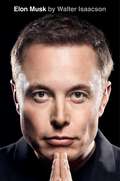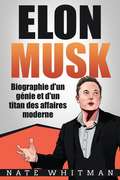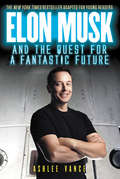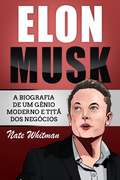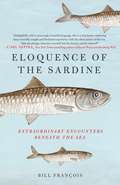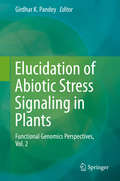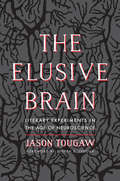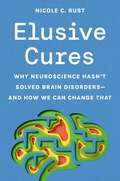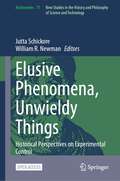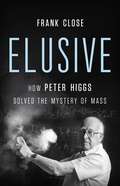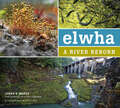- Table View
- List View
Ellen Ochoa (Hispanic Star)
by Claudia Romo Edelman Nathalie AlonsoRead about the first Latina in space, Ellen Ochoa, one of the most groundbreaking, iconic Hispanic and Latinx heroes that have shaped our culture and the world, in this gripping biography written by Claudia Romo Edelman and Nathalie Alonso, with black-and-white illustrations by Manuel Gutierrez, perfect for fans of the Who Was and She Persisted series. <p><p> Meet award-winning engineer and veteran astronaut Ellen Ochoa—once just a girl from Los Angeles, California. The granddaughter of Mexican immigrants, Ellen would pursue a career in physics at a young age and go on to earn master’s and doctorate degrees in electrical engineering from Stanford University. In 1993, Ellen became the first Latina in space. As a retired astronaut, she became the first Hispanic and second female director of the Johnson Space Center, has been an advocate for women and minorities in STEM fields, and was inducted into the Astronaut Hall of Fame.
Ellen Ochoa: Astronaut and Inventor
by Anne SchraffExplores the life of Ellen Ochoa from her childhood in California to her missions in space. On April 6, 1993, Ellen Ochoa, a mission specialist, sat in the space shuttle DISCOVERY, waiting for liftoff. As the launch pad rumbled and the engines ignited, the DISCOVERY exploded upward into the sky. With this space shuttle launch, Ellen Ochoa became the first Latina to enter space. A brilliant inventor and an experienced astronaut, Ochoa quickly moved up the ranks at NASA and toured schools throughout the country, encouraging students to follow their dreams.
Ellen DeGeneres: From Comedy Club to Talk Show (Extraordinary Success with a High School)
by Jaime SebaIn the last few decades, more and more people are going to college to further their education. It's hard to become a scientist, a professor, or a businessperson without getting some sort of college degree--but college isn't always necessary to achieve success. Some people are ready to enter the workforce right after high school. Ellen DeGeneres was one of those people. The comedian began her career doing stand-up routines in New Orleans coffee houses. Today, Ellen has one of the most successful talk shows on television and stars in commercials for everything from credit cards to makeup. She's even judged "American Idol"! And what's most amazing about her story is that the charming talk show host has done it all without a college degree!
Ellie, Engineer
by Jackson PearceA charming, hilarious illustrated middle grade about a girl who is an engineer--no, not the kind on a train, the kind that builds things! Perfect creative, STEM-powered fun for girls who have interests in how things work. Ellie is an engineer. With a tool belt strapped over her favorite skirt (who says you can’t wear a dress and have two kinds of screwdrivers handy, just in case?), she invents and builds amazing creations in her backyard workshop. Together with her best friend Kit, Ellie can make anything. As Kit’s birthday nears, Ellie doesn’t know what gift to make until the girls overhear Kit’s mom talking about her present--the dog Kit always wanted! Ellie plans to make an amazing doghouse, but her plans grow so elaborate that she has to enlist help from the neighbor boys and crafty girls, even though the two groups don’t get along. Will Ellie be able to pull off her biggest project yet, all while keeping a secret from Kit? Illustrated with Ellie’s sketches and plans, and including backmatter with a fun how-to guide to tools, this is a STEM- and friendship-powered story full of fun!
Ellipsometry at the Nanoscale
by Kurt Hingerl Maria LosurdoThis book presents and introduces ellipsometry in nanoscience and nanotechnology making a bridge between the classical and nanoscale optical behaviour of materials. It delineates the role of the non-destructive and non-invasive optical diagnostics of ellipsometry in improving science and technology of nanomaterials and related processes by illustrating its exploitation, ranging from fundamental studies of the physics and chemistry of nanostructures to the ultimate goal of turnkey manufacturing control. This book is written for a broad readership: materials scientists, researchers, engineers, as well as students and nanotechnology operators who want to deepen their knowledge about both basics and applications of ellipsometry to nanoscale phenomena. It starts as a general introduction for people curious to enter the fields of ellipsometry and polarimetry applied to nanomaterials and progresses to articles by experts on specific fields that span from plasmonics, optics, to semiconductors and flexible electronics. The core belief reflected in this book is that ellipsometry applied at the nanoscale offers new ways of addressing many current needs. The book also explores forward-looking potential applications.
Elliptic Extensions in Statistical and Stochastic Systems (SpringerBriefs in Mathematical Physics #47)
by Makoto KatoriHermite's theorem makes it known that there are three levels of mathematical frames in which a simple addition formula is valid. They are rational, q-analogue, and elliptic-analogue. Based on the addition formula and associated mathematical structures, productive studies have been carried out in the process of q-extension of the rational (classical) formulas in enumerative combinatorics, theory of special functions, representation theory, study of integrable systems, and so on. Originating from the paper by Date, Jimbo, Kuniba, Miwa, and Okado on the exactly solvable statistical mechanics models using the theta function identities (1987), the formulas obtained at the q-level are now extended to the elliptic level in many research fields in mathematics and theoretical physics. In the present monograph, the recent progress of the elliptic extensions in the study of statistical and stochastic models in equilibrium and nonequilibrium statistical mechanics and probability theory is shown. At the elliptic level, many special functions are used, including Jacobi's theta functions, Weierstrass elliptic functions, Jacobi's elliptic functions, and others. This monograph is not intended to be a handbook of mathematical formulas of these elliptic functions, however. Thus, use is made only of the theta function of a complex-valued argument and a real-valued nome, which is a simplified version of the four kinds of Jacobi's theta functions. Then, the seven systems of orthogonal theta functions, written using a polynomial of the argument multiplied by a single theta function, or pairs of such functions, can be defined. They were introduced by Rosengren and Schlosser (2006), in association with the seven irreducible reduced affine root systems. Using Rosengren and Schlosser's theta functions, non-colliding Brownian bridges on a one-dimensional torus and an interval are discussed, along with determinantal point processes on a two-dimensional torus. Their scaling limits are argued, and the infinite particle systems are derived. Such limit transitions will be regarded as the mathematical realizations of the thermodynamic or hydrodynamic limits that are central subjects of statistical mechanics.
Elmwood Park Zoo (Images of Modern America)
by Jerry Spinelli Stan HuskeyElmwood Park Zoo was established in 1924 when roughly 16 acres of land and a small group of animals were donated to the borough of Norristown. Although the early years of the zoo were more akin to a small farm, it has gone through an extensive expansion during the past few decades. This expansion and the continued revitalization of Elmwood Park Zoo include some notable residents, such as the zoo's owl, who has become the mascot of Temple University, and its bald eagle, a sideline regular for the NFL's Philadelphia Eagles. The zoo today, with new features including a zip line and a giraffe exhibit, looks to the future, with plans for even more exhibits, a new restaurant, and an additional 20 acres yet to be developed.
Elon Musk
by Walter IsaacsonDo autor de Steve Jobs e outras biografias de sucesso, chega-nos a história surpreendentemente íntima de um dos inovadores mais controversos e fascinantes da atualidade - um visionário avesso a regras que levou o mundo para a era dos carros elétricos, da exploração espacial de iniciativa privada e da inteligência artificial. Ah, e comprou o Twitter. Entrega a partir de 12 de Setembro de 2023.Durante a sua infância, na África do Sul, Elon Musk foi vítima de bullying. Um dia, foi empurrado de umas escadas de cimento abaixo e pontapeado no rosto até este ficar uma massa ensanguentada e inchada. Ficou internado durante uma semana. Mas as mazelas físicas eram insignificantes quando comparadas com as feridas emocionais infligidas pelo seu pai, um carismático e engenhoso fantasista que agia por conta própria. Quando Elon teve alta do hospital, o pai repreendeu-o. «Tive de ficar de pé uma hora a ouvi-lo gritar comigo, a chamar-me idiota e a dizer-me que era um inútil», recorda. O impacto do pai na sua psique permaneceria. Transformou-se num homem-criança duro, apesar de vulnerável, com uma tolerância extraordinariamente alta ao risco, sedento de drama e com um sentido épico de missão e uma obstinação maníaca, tão insensível quanto, por vezes, destrutiva. No início de 2022 ? depois de um ano marcado pelo lançamento e colocação em órbita de 31 foguetes da SpaceX, pela marca de um milhão de carros vendidos pela Tesla e de se tornar o homem mais rico do mundo ?, Musk falou com pesar sobre a sua compulsão para criar dramas. «Preciso de mudar de mentalidade, sair do modo de crise, que é como tenho funcionado nos últimos catorze anos, pelo menos, se não a maior parte da minha vida», disse. Foi um comentário melancólico, não uma resolução de Ano Novo. Ao mesmo tempo que se comprometia a mudar, comprava, em segredo, ações do Twitter, o maior recreio do mundo. Ao longo dos anos, sempre que se encontrava num lugar mais sombrio, voltava a ser aquela criança agredida no recreio. Agora, tinha a oportunidade de ser o dono do recreio. CRÍTICAS A STEVE JOBS, DE WALTER ISAACSON "Fascinante." - The New York Times "Hipnotizante" - LA Times "Vibrante." - Kirkus Reviews "Um retrato vasto e complexo - mas incrivelmente consistente - do homem que criou a Apple." - The Verge "Uma narrativa franca e cativante" - Publishers Weekly
Elon Musk
by Walter IsaacsonThe #1 New York Times and global bestseller from Walter Isaacson—the acclaimed author of Steve Jobs, Einstein: His Life and World, Benjamin Franklin, and Leonardo da Vinci—is the astonishingly intimate story of the most fascinating, controversial innovator of modern times. For two years, Isaacson shadowed Elon Musk as he executed his vision for electric vehicles at Tesla, space exploration with SpaceX, the AI revolution, and the takeover of Twitter and its conversion to X. The result is the definitive portrait of the mercurial pioneer that offers clues to his political instincts, future ambitions, and overall worldview. When Elon Musk was a kid in South Africa, he was regularly beaten by bullies. One day a group pushed him down some concrete steps and kicked him until his face was a swollen ball of flesh. He was in the hospital for a week. But the physical scars were minor compared to the emotional ones inflicted by his father, an engineer, rogue, and charismatic fantasist. His father&’s impact on his psyche would linger. He developed into a tough yet vulnerable man-child, prone to abrupt Jekyll-and-Hyde mood swings, with an exceedingly high tolerance for risk, a craving for drama, an epic sense of mission, and a maniacal intensity that was callous and at times destructive. At the beginning of 2022—after a year marked by SpaceX launching thirty-one rockets into orbit, Tesla selling a million cars, and him becoming the richest man on earth—Musk spoke ruefully about his compulsion to stir up dramas. &“I need to shift my mindset away from being in crisis mode, which it has been for about fourteen years now, or arguably most of my life,&” he said. It was a wistful comment, not a New Year&’s resolution. Even as he said it, he was secretly buying up shares of Twitter, the world&’s ultimate playground. Over the years, whenever he was in a dark place, his mind went back to being bullied on the playground. Now he had the chance to own the playground. For two years, Isaacson shadowed Musk, attended his meetings, walked his factories with him, and spent hours interviewing him, his family, friends, coworkers, and adversaries. The result is the revealing inside story, filled with amazing tales of triumphs and turmoil, that addresses the question: are the demons that drive Musk also what it takes to drive innovation and progress?
Elon Musk
by Walter IsaacsonFrom the author of Steve Jobs and other bestselling biographies, this is the astonishingly intimate story of the most fascinating and controversial innovator of our era—a rule-breaking visionary who helped to lead the world into the era of electric vehicles, private space exploration, and artificial intelligence. Oh, and took over Twitter.Australian Financial Review Top 20 Read for 2023 When Elon Musk was a kid in South Africa, he was regularly beaten by bullies. One day a group pushed him down some concrete steps and kicked him until his face was a swollen ball of flesh. He was in the hospital for a week. But the physical scars were minor compared to the emotional ones inflicted by his father, an engineer, rogue, and charismatic fantasist. His father&’s impact on his psyche would linger. He developed into a tough yet vulnerable man-child, prone to abrupt Jekyll-and-Hyde mood swings, with an exceedingly high tolerance for risk, a craving for drama, an epic sense of mission, and a maniacal intensity that was callous and at times destructive. At the beginning of 2022—after a year marked by SpaceX launching thirty-one rockets into orbit, Tesla selling a million cars, and him becoming the richest man on earth—Musk spoke ruefully about his compulsion to stir up dramas. &“I need to shift my mindset away from being in crisis mode, which it has been for about fourteen years now, or arguably most of my life,&” he said. It was a wistful comment, not a New Year&’s resolution. Even as he said it, he was secretly buying up shares of Twitter, the world&’s ultimate playground. Over the years, whenever he was in a dark place, his mind went back to being bullied on the playground. Now he had the chance to own the playground. For two years, Isaacson shadowed Musk, attended his meetings, walked his factories with him, and spent hours interviewing him, his family, friends, coworkers, and adversaries. The result is the revealing inside story, filled with amazing tales of triumphs and turmoil, that addresses the question: are the demons that drive Musk also what it takes to drive innovation and progress?
Elon Musk (edición en español)
by Walter IsaacsonDel autor de Steve Jobs y otras grandes biografías, todas ellas éxitos internacionales de ventas, esta es la historia asombrosamente íntima del innovador más fascinante y polémico del mundo, un visionario que ha roto todos los moldes y ha conducido al mundo a la era de los vehículos eléctricos, la exploración espacial privada y la inteligencia artificial. Ah, y el mismo que compró Twitter.Cuando Elon Musk era un niño en Sudáfrica, sufría a menudo acoso escolar. Un día un grupo de niños lo empujó por unas escaleras de hormigón y le patearon hasta que su cara se hinchó como una pelota. Pasó una semana en el hospital. Pero las cicatrices físicas fueron insignificantes comparadas con las emocionales, las que le había causado su padre, un canalla, ingeniero carismático y fantasioso. Cuando Elon llegó a casa tras ser dado de alta del hospital, su padre le reprendió. «Tuve que escucharlo durante una hora mientras me gritaba, me llamaba idiota y me decía que era un inútil», recuerda. El impacto psicológico que su padre le causó perduró. Se convirtió en un joven fuerte pero vulnerable al mismo tiempo, propenso a bruscos cambios de humor -a lo Jekyll y Hyde-, con una gran tolerancia al riesgo, ansias de drama, un épico sentido de misión y una intensidad maníaca, cruel y a veces destructiva.A principios de 2022, después de un año marcado por el lanzamiento de treinta y un satélites de SpaceX, la venta de un millón de coches de Tesla y de convertirse en el hombre más rico de la tierra, Musk confesó con arrepentimiento su impulso por provocar el drama. «Necesito cambiar mi forma de pensar para que deje de estar en modo crisis, como lo he estado en los últimos catorce años, o probablemente toda mi vida», explicó.Fue un comentario melancólico, no un propósito de año nuevo. Cuando hizo la promesa, estaba comprando en secreto acciones de Twitter, el patio de recreo por excelencia. Con los años, cuando se encontraba en un momento difícil, se veía transportado de nuevo al acoso que sufrió en el patio del colegio. Ahora tenía la oportunidad de poseerlo. Durante dos años, Isaacson fue la sombra de Musk, asistió a sus reuniones, recorrió juntos sus fábricas, y pasó horas entrevistándolo a él, a su familia, amigos, compañeros y adversarios. El resultado es un relato íntimo y revelador, repleto de historias asombrosas, triunfos y perturbaciones, que aborda la pregunta: ¿son los demonios que mueven a Musk también lo que se necesita para impulsar la innovación y el progreso?
Elon Musk - Biographie d'un génie et d'un titan des affaires moderne
by Nate WhitmanElon Musk est indéniablement un titan des affaires. Il contrôle des entreprises gigantesques telles que Tesla et SpaceX et a cimenté sa place dans l'histoire de l'humanité - mais combien connaissez-vous vraiment l'homme qui se trouve derrière tout cela ? Dans ce livre détaillé de la vie et de la carrière d’Elon Musk, vous découvrirez son enfance et ses études en Afrique du Sud, ses modestes débuts sur le continent américain et ses premiers pas dans le monde des affaires. Des débuts de Zip2 et X.com qui ont marqué les débuts de la carrière de Musk à SpaceX et Tesla que nous connaissons aujourd'hui, vous découvrirez comment une idée inconnue et modeste a conduit à la fondation de SpaceX, à la révolution que Tesla a apporté aux voitures électriques, et comment ces entreprises (et Musk lui-même) continuent de résister malgré tout. Mais au-delà du commerce, vous aurez également la chance d’avoir un aperçu de l'homme lui-même - l'image publique polarisante de Musk, ses innombrables bizarreries et des sensations célèbres telles que Not-A-Flamethrower et le site d'évaluation des médias Pravduh. Depuis les opinions politiques et religieuses de Musk jusqu'à son apparition dans des sous-cultures Internet clés, Elon Musk : Biographie d'un génie et d'un titan des affaires moderne donne un aperçu unique et puissant de l'un des hommes les plus célèbres du monde.
Elon Musk and the Quest for a Fantastic Future Young Readers' Edition
by Ashlee VanceAn in-depth look into the extraordinary life of the world’s most important entrepreneur, Elon MuskThis fascinating and easily accessible young readers’ adaptation of Ashlee Vance’s New York Times bestselling Elon Musk: Tesla, SpaceX, and the Quest for a Fantastic Future features black-and-white photographs throughout and an epilogue. The version for adults has been praised as “riveting” (The Financial Times), “spirited” (The Wall Street Journal), and “masterful” (Vice). Now younger readers can read about this innovative leader who is revolutionizing three industries at once: space, automotive, and energy.There are few people in history who could match Elon Musk’s relentless drive and vision. A modern combination of famous inventors and industrialists like Thomas Edison, Henry Ford, and Steve Jobs, Elon is the man behind companies such as SpaceX, Tesla Motors, SolarCity, and PayPal that are transforming the way we live.Written with exclusive access to Elon, his family, and his friends, this book traces Elon’s journey from a kid in South Africa to a young man in the United States, his dramatic technical inventions, and his world-changing companies. Elon has sparked new levels of innovation in the world, and this book gives young readers a detailed but fast-paced look at his story. A Junior Library Guild Selection!
Elon Musk: A Biografia de um Gênio Moderno e Titã dos Negócios
by Nate WhitmanElon Musk é, sem dúvida, um titã dos negócios. Ele controla empresas gigantes, como a Tesla e a SpaceX, e se consolidou na História, para sempre - mas quanto você realmente sabe sobre o homem por trás de tudo isso? Nesse relato detalhado sobre a vida e a carreira de Elon Musk, você aprenderá sobre sua infância e vida escolar na África do Sul, seu humilde começo no continente americano, e seus primeiros empreendimentos nos negócios. Partindo das antigas Zip2 e X.com, as quais marcaram o início da carreira de Musk, às empresas de ponta SpaceX e Tesla, pelas quais chegamos a conhecê-lo, você descobrirá como uma ideia obscura e despretenciosa levou à fundação da SpaceX, como a Tesla revolucionou carros elétricos, e como essas empresas (e o próprio Musk) continuam a sobreviver a todas as dificuldades. Mas, além dos negócios, você também terá a chance de observar o próprio homem - A polarizada imagem pública de Musk, suas incontáveis brincadeiras, e famosas sensações, como o Not-A-Flamethrower e o site de avaliação de mídia, Pravduh. Das visões política e religiosa de Musk à sua aparição em estruturas-chave da Internet, Elon Musk: A Biografia de um Gênio Moderno e Titã dos Negócios oferece uma perspectiva única e poderosa em um dos homens mais famosos do mundo.
Elon Musk: A Mission to Save the World
by Anna Crowley ReddingElon Musk, visionary behind SpaceX and CEO of both the electric car company Tesla and the social media platform Twitter, is constantly generating headlines. But how did he get there? This riveting and beautifully designed YA biography shows how a once-bullied school boy became a figure the New York Times described as "arguably the most important and successful entrepreneur in the world." Online banking, reusable rockets, electric sports cars, improved solar power, colonizing Mars—Elon Musk is full of unique, daring, and highly-publicized ideas that he believes will help save the world. But behind his legendary drive and the mind-blowing headlines seen on CNN, Forbes, or The Wall Street Journal is the story of a bullied and beaten school boy who, through creativity and determination, decided to rewrite his narrative and find groundbreaking ways to make the world a better place. With the sense of fun and style that he has become so well-known for, of course.From hosting raves to pay for college to rewriting the rules on space travel, Elon Musk has always gone his own way, to either the dismay or admiration of the general public. And now, award-winning investigative journalist Anna Crowley Redding takes readers on a well-researched trip through Elon's life and accomplishments.
Eloquence of the Sardine: Extraordinary Encounters Beneath the Sea
by Bill FrançoisIf we were able to listen under water, what would we hear? What would we learn? How would it change us?With erudition and charm, marine scientist and orator Bill François takes us on a deep dive into the secret lives of the world’s aquatic creatures, from musical whales and immortal eels to the cod that discovered America and the herring that almost caused a military conflict —to name but a few. We hear the songs of seahorses and scallops, eavesdrop on the conversations of lobsters, and swim in the glow of the fluorescent jellyfish. A poetic blend of ancient myths, modern science, and storytelling through the ages, Eloquence of the Sardine is an invitation and guide to a dreamlike underwater world where the legends are often more believable than the incredible reality. This is nature writing at its best —informative, captivating, and accessible, with a personal angle, about an endlessly fascinating and still mysterious subject.A seafood platter or a day at the beach will never be the same.
Elsa: The Story of the Famous Lioness of "Born Free"
by Joy AdamsonFrom the Book Jacket: The true story of a lioness who was brought up from cubhood by JOY ADAMSON and her husband, a senior game warden; they taught her to stalk and kill for herself so that she could be set free into the African Jungle With Picture Descriptions
Elsevier's Veterinary Assisting Textbook
by Margi SiroisBased on NAVTA-approved guidelines, Elsevier's Veterinary Assisting Textbook by Margi Sirois offers comprehensive coverage of the knowledge and skills you need for a successful career in veterinary assisting. You'll learn about the role of the veterinary assistant and how to perform key responsibilities of the job, including assisting the veterinary technician and the veterinarian by restraining animals, setting up equipment and supplies, cleaning and maintaining practice and laboratory facilities, and feeding and exercising patients. Targeted coverage addresses only those topics that are relevant to veterinary assisting. Authoritative content covers everything you need to know to pass the Approved Veterinary Assistant (AVA) exam and succeed in clinical practice. Authors and contributors are leading experts in veterinary medicine, veterinary technology, and veterinary assisting.
Elucidation of Abiotic Stress Signaling in Plants
by Girdhar K. PandeyAbiotic stresses such as high temperature, low-temperature, drought, and salinity limit crop productivity worldwide. Understanding plant responses to these stresses is essential for rational engineering of crop plants. In Arabidopsis, the signal transduction pathways for abiotic stresses, light, several phytohormones and pathogenesis have been elucidated. A significant portion of plant genomes (most studies are Arabidopsis and rice genome) encodes for proteins involves in signaling such as receptor, sensors, kinases, phosphatases, transcription factors and transporters/channels. Despite decades of physiological and molecular effort, knowledge pertaining to how plants sense and transduce low and high temperature, low-water availability (drought), water-submergence and salinity signals is still a major question before plant biologists. One major constraint hampering our understanding of these signal transduction processes in plants has been the lack or slow pace of application of molecular genomic and genetics knowledge in the form of gene function. In the post-genomic era, one of the major challenges is investigation and understanding of multiple genes and gene families regulating a particular physiological and developmental aspect of plant life cycle. One of the important physiological processes is regulation of stress response, which leads to adaptation or adjustment in response to adverse stimuli. With the holistic understanding of the signaling pathways involving not only one gene family but multiple genes or gene families, plant biologists can lay a foundation for designing and generating future crops that can withstand the higher degree of environmental stresses (especially abiotic stresses, which are the major cause of crop loss throughout the world) without losing crop yield and productivity.
Elusive Brain: Literary Experiments in the Age of Neuroscience
by Jason Tougaw Joseph E. LeDouxFeaturing a foreword by renowned neuroscientist Joseph E. LeDoux, The Elusive Brain is an illuminating, comprehensive survey of contemporary literature’s engagement with neuroscience. This fascinating book explores how literature interacts with neuroscience to provide a better understanding of the brain’s relationship to the self. Jason Tougaw surveys the work of contemporary writers—including Oliver Sacks, Temple Grandin, Richard Powers, Siri Hustvedt, and Tito Rajarshi Mukhopadhyay—analyzing the way they experiment with literary forms to frame new views of the immaterial experiences that compose a self. He argues that their work offers a necessary counterbalance to a wider cultural neuromania that seeks out purely neural explanations for human behaviors as varied as reading, economics, empathy, and racism. Building on recent scholarship, Tougaw’s evenhanded account will be an original contribution to the growing field of neuroscience and literature.
Elusive Cures: Why Neuroscience Hasn’t Solved Brain Disorders—and How We Can Change That
by Professor Nicole C. RustA neuroscientist&’s bold proposal for tackling one of the greatest challenges of our time—brain and mental illnessesBrain research has been accelerating rapidly in recent decades, but the translation of our many discoveries into treatments and cures for brain disorders has not happened as many expected. We do not have cures for the vast majority of brain illnesses, from Alzheimer&’s to depression, and many medications we do have to treat the brain are derived from drugs produced in the 1950s—before we knew much about the brain at all. Tackling brain disorders is clearly one of the biggest challenges facing humanity today. What will it take to overcome it? Nicole Rust takes readers along on her personal journey to answer this question.Drawing on her decades of experience on the front lines of neuroscience research, Rust reflects on how far we have come in our quest to unlock the secrets of the brain and what remains to be discovered. She shows us that treating a brain disorder is more like redirecting a hurricane than fixing a domino chain of cause and effect, arguing that only once we embrace the idea of the brain as a complex system do we have any hope of finding cures. Rust profiles the pioneering ideas about the brain that are driving research at the cutting edge to illuminate exactly how much we know about disorders such as Parkinson&’s, epilepsy, addiction, schizophrenia, and anxiety—and what it will take to eradicate these scourges.Elusive Cures sheds light on one of the most daunting challenges ever confronted by science while offering hope for revolutionary new treatments and cures for the brain.
Elusive Phenomena, Unwieldy Things: Historical Perspectives on Experimental Control (Archimedes #71)
by Jutta Schickore William R. NewmanThis open access book provides a historical treatment of scientific control in experimentation in the longue durée. The introduction distinguishes four related strands in the history of experimental control: the development of practices to stabilize experimental conditions; the career of the comparative design; the unfolding of methodological discussions about control practices and designs; and the history of the term “control”. Each chapter brings these distinctions to bear on specific historical episodes. The focus is on experiments with complex, elusive phenomena such as perception and learning, irregular movements, and unobservable elements. Such experiments bring control issues to the fore because they are difficult to design and stabilize and often controversial. Together, the chapters show that the local context shapes what exactly is controlled, how control can be accomplished, and how controls are justified. They also show that control strategies and methodological ideas often remain stable for a long time and change only gradually. This book, as well as the volume on analysis and synthesis in experimentation by the same editors, contains contributions by an array of experts from multiple disciplines, making it suitable for historians and philosophers of science and students alike.
Elusive: How Peter Higgs Solved the Mystery of Mass
by Frank Close*A New York Times Book Review Editor's Choice Selection* The first major biography of Peter Higgs, revealing how a short burst of work changed modern physics On July 4, 2012, the announcement came that one of the longest-running mysteries in physics had been solved: the Higgs boson, the missing piece in understanding why particles have mass, had finally been discovered. On the rostrum, surrounded by jostling physicists and media, was the particle&’s retiring namesake—the only person in history to have an existing single particle named for them. Why Peter Higgs? Drawing on years of conversations with Higgs and others, Close illuminates how an unprolific man became one of the world&’s most famous scientists. Close finds that scientific competition between people, institutions, and states played as much of a role in making Higgs famous as Higgs&’s work did. A revelatory study of both a scientist and his era, Elusive will remake our understanding of modern physics.
Elwha: A River Reborn
by Lynda V. MapesIn the fall of 2011, the Times was on hand when a Montana contractor removed the first pieces from two concrete dams on the Elwha River which cuts through the Olympic range. It was the beginning of the largest dam removal project ever undertaken in North America—one dam was 200 feet tall—and the start of an unprecedented attempt to restore an entire ecosystem. More than 70 miles of the Elwha and its tributaries course from the mountain headwaters to clamming beaches on the Strait of Juan de Fuca. Through interviews, field work, archival and historical research, and photojournalism, The Seattle Times has explored and reported on the dam removal, the Elwha ecosystem, its industrialization, and now its renewal. Elwha: A River Reborn is based on these feature articles.










